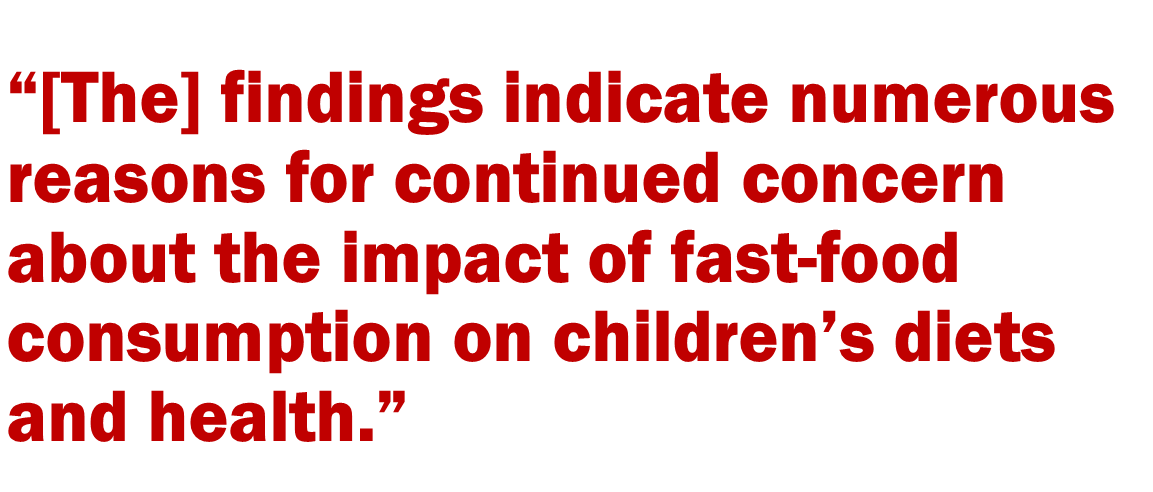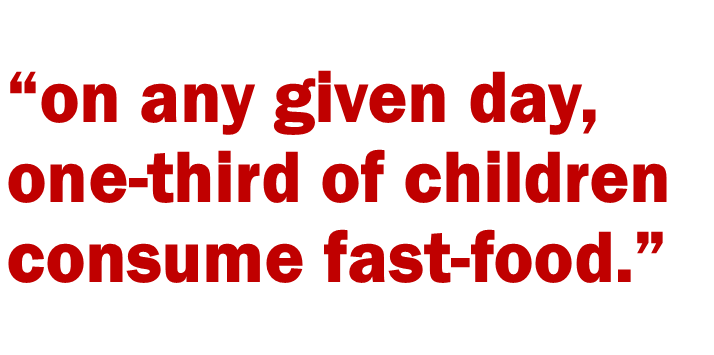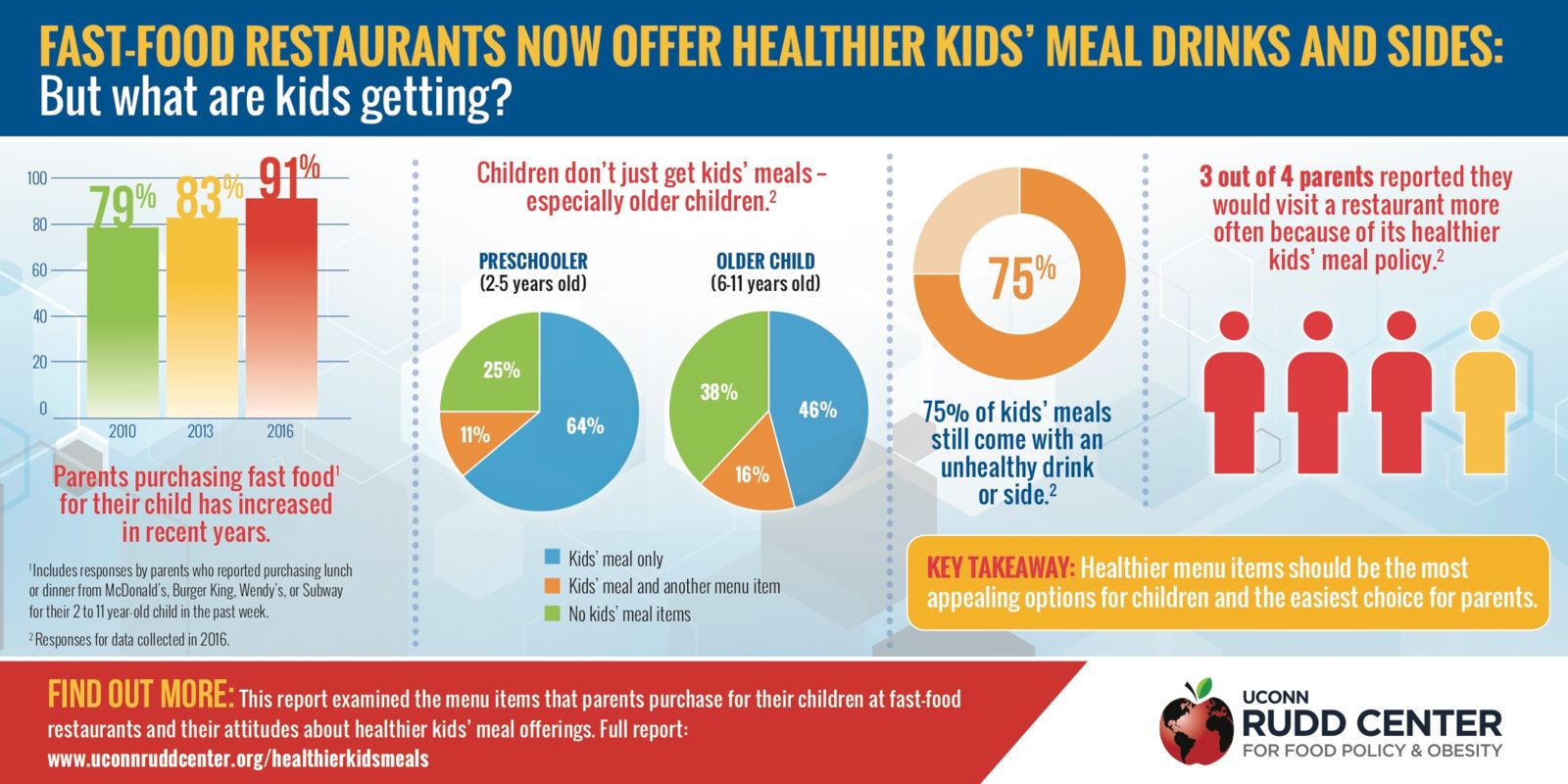PERSPECTIVE: Unhealthy Options Persist in Fast Food; Voluntary Efforts Falling Short
/Fast-food consumption is associated with poor diet quality in youth. Therefore, improving the nutritional quality of fast-food meals consumed by children is an important public health objective.
In response to public health concerns, several of the largest fast-food restaurants have introduced policies to offer healthier drinks and/or sides with their kids’ meals. However, few research studies have examined the menu items that parents purchase for their children at fast-food restaurants or their attitudes about healthier kids’ meal offerings.
The primary purpose of [a study by the UConn Rudd Center for Food Policy & Obesity] was to document parents’ reported fast-food purchases for their children (ages 2-11) and examine changes over time. [The] findings indicate numerous reasons for continued concern about the impact of fast-food consumption on children’s diets and health.
In 2016, we identified 10 different fast-food restaurants where at least one-quarter of parents reported that they purchased food for their child(ren) weekly or more often. In addition, more than 90% of parents surveyed reported that they visited at least one of the four largest fast-food restaurants to purchase lunch or dinner for their child (ages 2-11) in the past week, and they purchased food for their child at 2.4 of these restaurants on average.
 These numbers are high, but they correspond to previous research showing that on any given day, one-third of children consume fast-food… Furthermore, parents’ purchases of fast-food for their children increased significantly during the years examined, with parents reporting increased frequency of visits to most individual fast-food restaurants from 2013 to 2016…
These numbers are high, but they correspond to previous research showing that on any given day, one-third of children consume fast-food… Furthermore, parents’ purchases of fast-food for their children increased significantly during the years examined, with parents reporting increased frequency of visits to most individual fast-food restaurants from 2013 to 2016…
These results also suggest that healthier kids’ meal policies could result in unintended public health consequences if they lead parents to view the restaurants more positively and increase their visits, but continue to order the unhealthy items for their child.
These findings indicate numerous opportunities for restaurants to enhance their efforts to improve the nutritional quality of fast-food consumed by children.
First, restaurants should introduce healthier kids’ meals that are also appropriate and appealing to older children… In addition, restaurants must discontinue the increasingly common practice of offering unhealthy sides together with healthier sides, and/or they should remove unhealthy sides from their kids’ meal menus altogether, as they have pledged to do with kids’ meal drinks…
Finally, since parents often choose restaurants that are convenient and that their kids like (more than for healthy options), restaurants should make the healthier items the most appealing options for children to choose. They should also make the healthier items the easiest options for parents to order, for example, by making them the default for kids’ meals. Given parents’ positive attitudes about healthier kids’ meals, there appears to be a substantial marketing opportunity for restaurants to introduce and promote healthier kids’ meals that appeal to both parents and children…
If restaurants do not implement further improvements voluntarily, advocates should continue to work with state and local municipalities to introduce public policies to improve the healthfulness of kids’ meals. Policy makers should follow the lead of communities in California and Colorado and consider legislation or regulation to require that all restaurants serve healthier kids’ meals…
 Unhealthy options, including main dishes, sides, and desserts, remain on kids’ meal menus at most restaurants, and purchases of a kids’ meal plus another menu item for their child have increased. Although future research is required to explain the reasons for these trends, they do indicate that restaurants’ voluntary pledges, as currently implemented, are unlikely to substantially reduce children’s fast-food consumption overall, or increase their selection of available healthier drink and side options.
Unhealthy options, including main dishes, sides, and desserts, remain on kids’ meal menus at most restaurants, and purchases of a kids’ meal plus another menu item for their child have increased. Although future research is required to explain the reasons for these trends, they do indicate that restaurants’ voluntary pledges, as currently implemented, are unlikely to substantially reduce children’s fast-food consumption overall, or increase their selection of available healthier drink and side options.
Furthermore, parents’ positive attitudes about restaurants’ healthier kids’ meal policies indicate that such policies could backfire for public health and increase the frequency of purchasing fast-food for their children without increasing healthier purchases. These findings demonstrate that restaurants must implement more effective healthier kids’ meal policies to avoid additional state and local regulations that would mandate healthier options for children.
_________________________
This is an excerpt from Parents’ Reports of Fast Food Purchases for Their Children: Have They Improved?, published in September 2018 by the Rudd Center for Food Policy & Obesity at the University of Connecticut. The report’s authors are Jennifer L. Harris, Maia Hyary, Nicole Seymour and Yoon Young Choi. The full report is available here.
https://youtu.be/2Ng_X4D4SSA






























